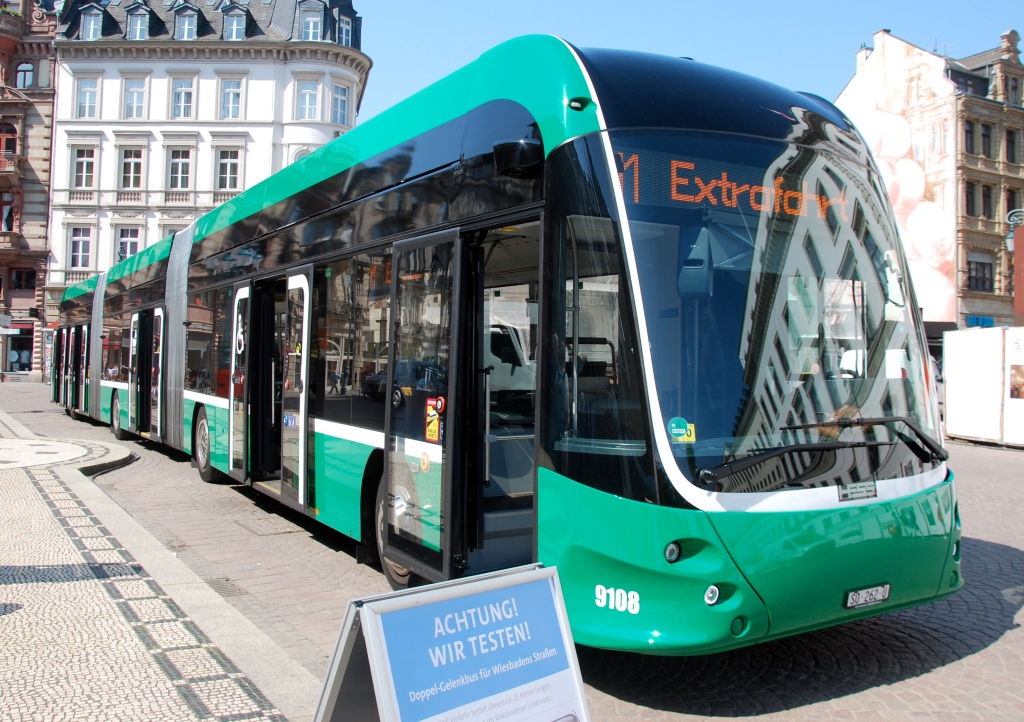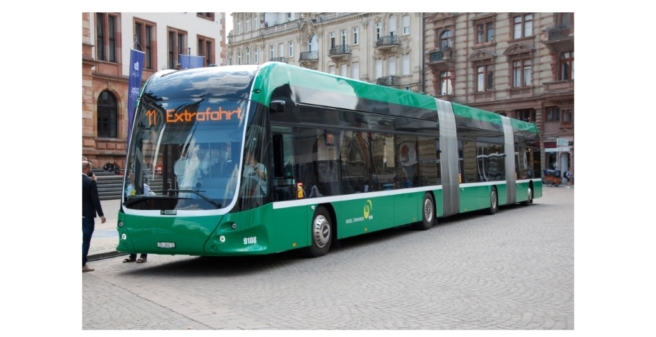
Presentation in front of Wiesbaden’s town hall
Tuesday, 06 June 2023, Wiesbaden, Schlossplatz: In front of the town hall of the Hessian state capital stands a large green vehicle of, for the time being, still unusual dimensions. It is a “HESS lighTram® 25 OPP”, which is almost 25 metres long (exactly 24,370 mm). For a two-week test of such a bus on Wiesbaden’s streets, manufacturer Hess and Basel’s municipal transport operator BVB provided the Basel tram 9108. It has been operating in Basel approximately 30,000 kilometres already since it was registered in spring and runs in Basel together with its ‘brothers’ 9101 to 9107 on line 50 (Basel Central Station – Basel/Mulhouse Airport). The line is about seven kilometres long, with one terminus being located at the airport in France. The eight double-articulated buses on this line are so-called “opportunity chargers” – hence the “OPP” in the type designation. They are recharged via pantograph during operation on their line, remarkably the two charging masts for the buses are located at the airport and thus in France.
The official statements
The presentation of the double articulated bus was attended by Andreas Kowol, Wiesbaden’s head of transport, Marion Hebding, who has been ESWE’s commercial director for only a few days (1 June), and Jan Görnemann, her colleague in charge of technology. Kowol explained that after the failed referendum, which rejected the idea of reintroducing a tram, Wiesbaden now had to look for other ways to transport large numbers of passengers. In 2019, the last year before the Corona pandemic, 61,256 million passengers were carried, and the number of passengers has now returned to pre-pandemic levels, with the trend continuing to rise. Since at the same time fewer and fewer people want to do the job of driver, it is necessary to transport more people in larger vehicles with fewer drivers. “That’s the only way the transport turnaround can succeed.”
Marion Hebding, the new commercial manager of ESWE, stressed the importance of extensive testing of a new type of vehicle before putting such vehicles out to tender and ordering them. Without naming a specific episode in Wiesbaden, she said that in the past there had been a procurement mistake because the company had not sufficiently considered what it was buying.
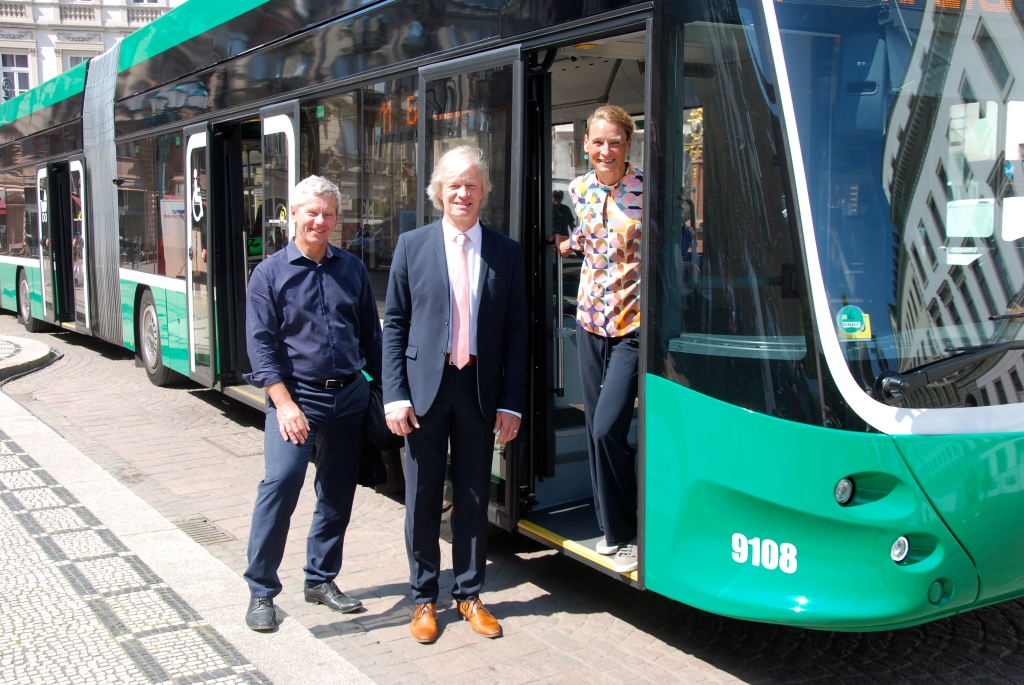
In his speech, the technical manager Jan Görnemann addressed the question of whether double-articulated buses were suitable for Wiesbaden at all. His answer was a clear “yes”. Although the double-articulated bus is six to seven metres longer than a conventional articulated bus, thanks to the steered fourth axle (mechanical forced steering) it has the same turning circle and behaviour at curved and corners as a conventional articulated bus. “Where the conventional articulated bus can get through, the double-articulated bus will also do.
The fully loaded double articulated bus weighs almost 40 tonnes (exactly 39,282 kg). But since this weight is distributed over four axles, the single axle does not weigh more heavily on the road than the single axle of a conventional articulated bus. Fears that a double-articulated bus would wreck the roads are therefore completely unfounded.
Görnemann pointed out that double-articulated buses from Hess have already been in use for some time as trolleybuses in Lucerne, Sankt Gallen and Zurich and as battery electric buses in Basel (CH), Nantes (F) and Brisbane (AUS). So Hess knows what they are doing and there are no complications of any kind.
The demonstration drive
A demonstration ride followed from Schlossplatz in the old town through Wiesbaden’s city centre to the main railway station. The author mainly observed the behaviour of the rear section (the third) in the curves. In short: the rear car behaved completely unspectacularly, neither swung out far in the curve nor did it run in unusually far towards the centre of the curve.
As an electric bus, the Basel vehicle proved to be amazingly quiet in Wiesbaden. Nothing could be heard from its two electric central motors (one each on the two driven, twin-tyred axles 2 and 3). On the other hand, the air-conditioning system let us know that it was hard at work. Note: The two steered axles 1 and 4 are of course only single-tyred.
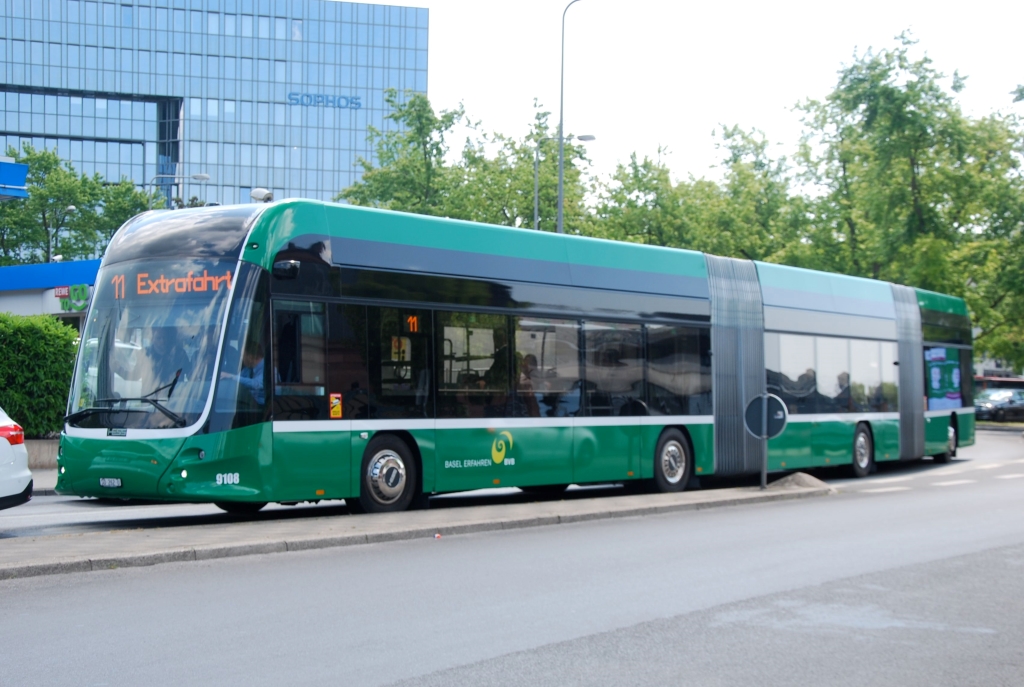
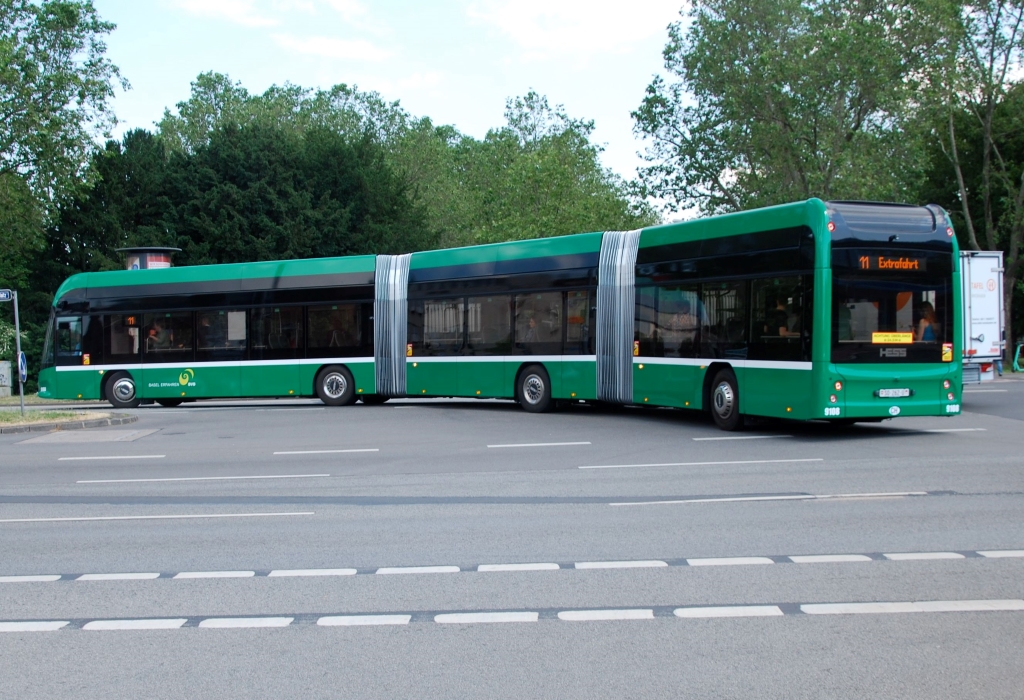
Only internal ESWE test runs
Bus 9108 arrived in Wiesbaden on 2 June, it will stay until 16 June. On Saturday, 10 June, Wiesbaden’s citizens can take a good look at it at the main station. It will not be on the line in Wiesbaden because there is currently no German registration for it. But Managing Director Görnemann says: “We can also find out this way how we get along with him in the city and gather our experience.”
The next steps
The Hess double-articulated bus will now be tested for a fortnight in Wiesbaden. Afterwards, the test results will be evaluated. Possibly, double-articulated buses from other manufacturers will also be tested. A tender for such buses will be issued in two years at the earliest, so double-articulated buses will not go into service with ESWE for at least three years. The author said to the commercial manager: “If you were to invite tenders now, you could only get three offers: from Hess, Solaris and Van Hool. No one else builds such buses.” Her answer: “The double-articulated bus is coming. By the time we put the coaches out to tender, there will be other manufacturers who will be happy to offer us such buses.”
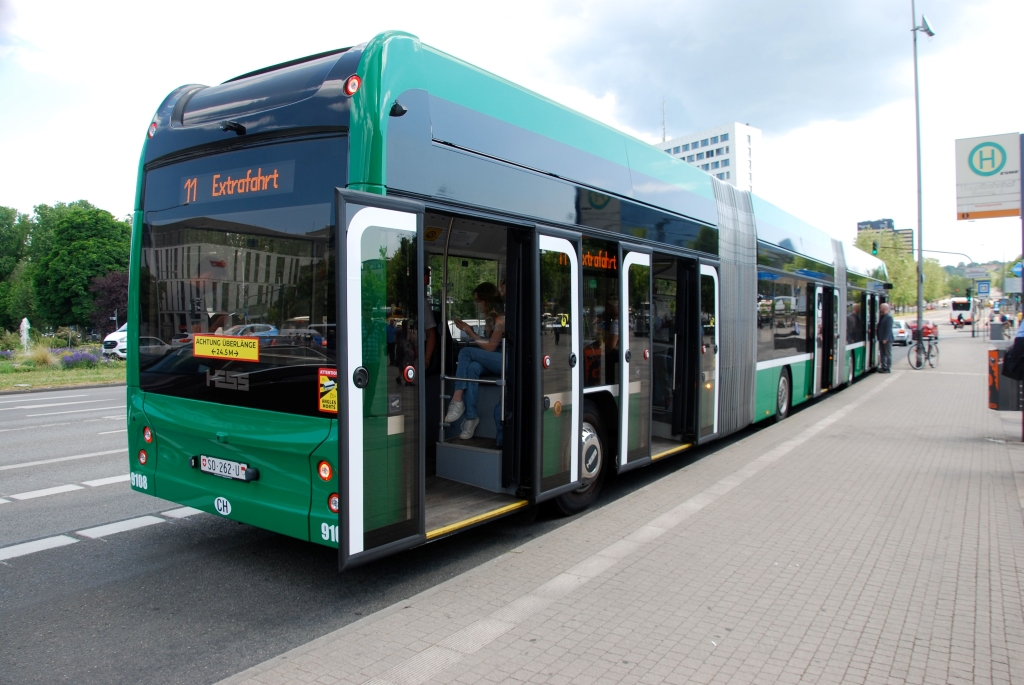
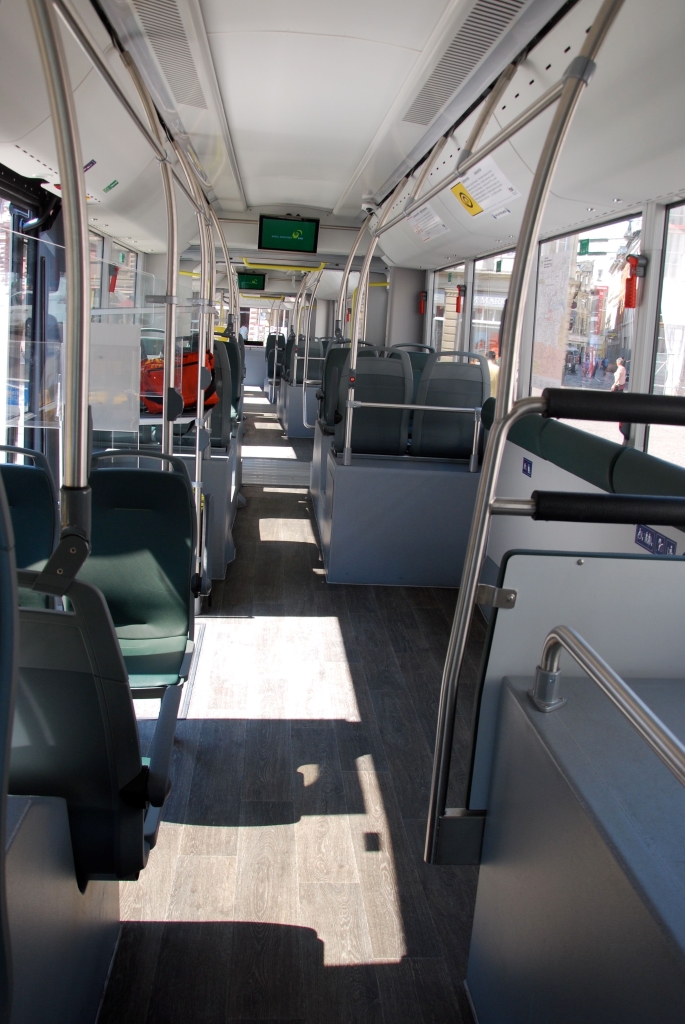
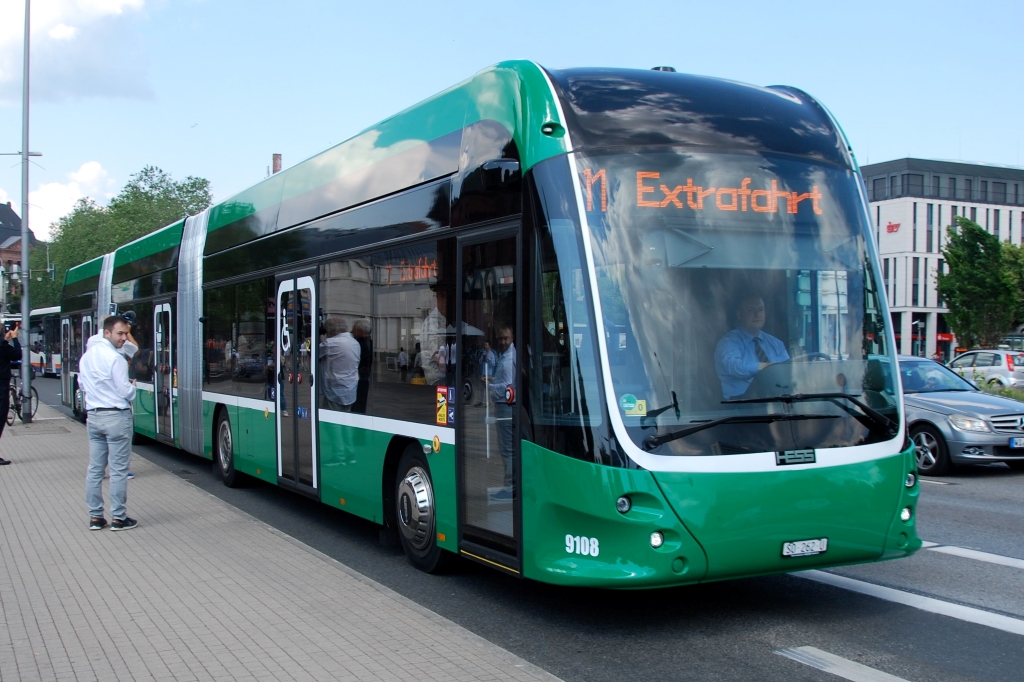
About ESWE’s Caetano H 2 City Gold
At the end of 2021, ESWE purchased ten hydrogen buses from the Portuguese manufacturer Caetano of the type “H 2 City Gold”, but at the end of 2022, after one year, decided not to pursue the concept of powering buses with hydrogen and fuel cells any further. So there they were, ten Caetano H 2 City Gold, looking for someone who wanted them. Five of them very quickly found a new home in Wiesbaden’s neighbouring city of Mainz with the MVG there, just across the Rhine. But what will happen to the other five, Jan Görnemann was asked? Görnemann: “There are several transport companies that want to take over these buses. So we will be able to sell them very well for the highest bid.” Görnemann did not communicate who the interested parties are for these remaining five buses.
Technical data of the Hess LighTram 25 Opp
Manufacturer: Hess AG, Bellach / Switzerland
Type: LighTram 25 Opp
Year of first registration: 2023
Length: 24,370 mm
Width: 2.550 mm
Height: 3.410 mm
Unladen weight: 25,274 kg
Gross vehicle weight: 39,282 kg
Passenger capacity: 206 passengers, of which: 44 seated, 162 standing
Doors: four double-width doors, one single-width door (driver’s entrance)
Drive axles ( 2 and 3): ZF electric portal axles
The rear carriage is mechanically power-steered via movable metal rods attached to the second joint and acting on the fourth axle
Batteries: eight modules, total capacity: 533 kWh
Range: 200 km (practically unlimited thanks to recharging on the line)
Note: The front and middle carriages are built as shells in the Hess factory in Portugal and then go to the main factory in Bellach for completion; the rear carriage is manufactured completely in Bellach.
